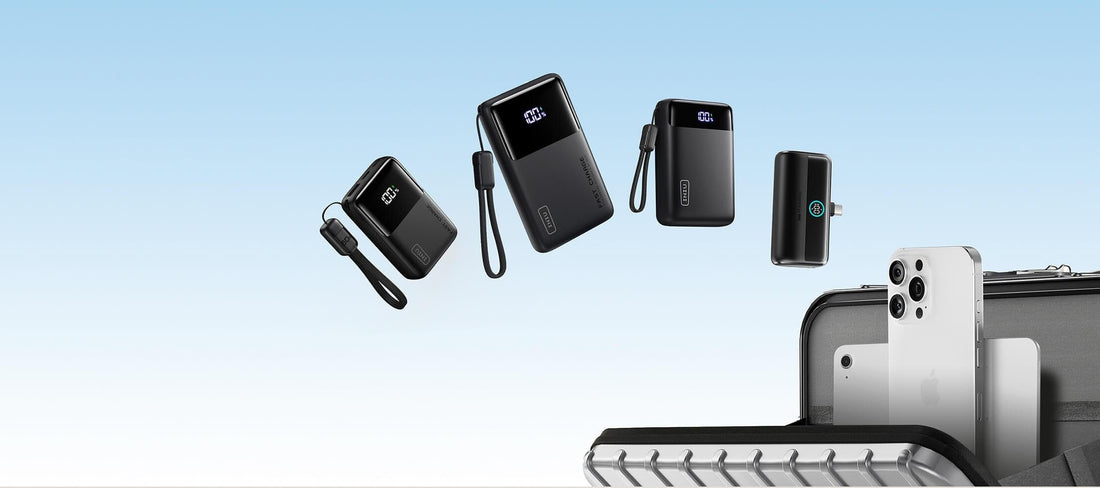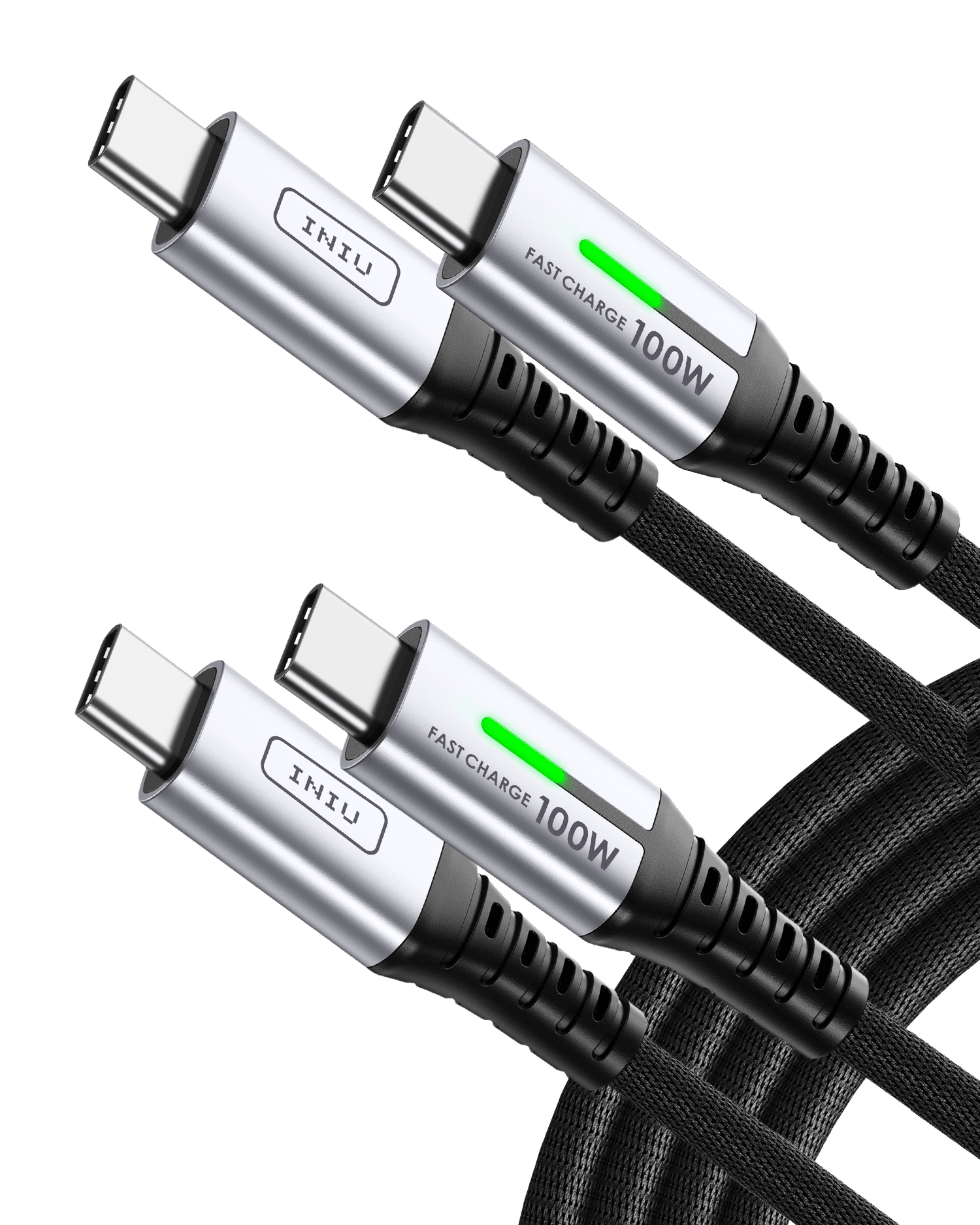
What Is the Best Type of Power Bank?
Whether you're powering a smartphone, laptop, or camping gear, choosing the best portable power bank means more than picking a big battery. You need the right balance of capacity, output power, portability, and compatibility. From iPhone users looking for a sleek MagSafe power bank to digital nomads needing a laptop power bank, this comprehensive guide helps you understand which type is best for your needs.
Let's break down the different types of portable power banks, their ideal use cases, and the key specs to consider.
What Is the Most Common Type of Portable Power Bank for General Use?

The most common type of power bank is the standard model with no built-in cables or magnetic features. These are ideal for daily use when you're primarily charging smartphones or tablets.
Key Features:
- USB-A and USB-C output
- 10,000–15,000mAh capacity
- Often includes quick charge (QC 3.0) or Power Delivery (PD 18W)
Technical Insight:
Look for a model that supports at least 18W PD output for fast phone charging. If you're charging newer iPhones or Android devices, USB-C to USB-C or USB-C to Lightning cables are ideal.
Best for:
- Commuters
- Students
- Everyday phone users
These models are often the most affordable and user-friendly, making them the best portable power bank choice for the average consumer. INIU Carry P50-E1 power bank features the industry-first TinyCell Pro battery, redefines the industry standard for the smallest 10000 mAh power bank size. With a maximum output of 45W, it supports PD, QC, and Samsung Super Fast Charging, which can help you quickly restore power in daily life.
Are Power Banks with Built-In Cables Better for Everyday Use?

If convenience is your top priority, consider a power bank with integrated charging cables. These are all-in-one solutions, typically including Lightning, USB-C, or Micro USB.
Pros:
- No need to carry separate cables
- Great for travel or emergencies
- Usually include multiple outputs
Caution:
Make sure the built-in cable supports PD fast charging if you're charging high-draw devices. Some budget models only offer slow charging (5V/1A).
Best for:
- Travelers
- Families with mixed-device ecosystems
- Emergency kits
These all-in-one devices are growing in popularity, particularly for users who forget to pack accessories. INIU Carry P51L-E2 power bank features built-in USB-C cable, allowing you to charge anytime and anywhere without carrying an extra charging cable.
Is a MagSafe Power Bank Worth It for iPhone Users?

The MagSafe power bank category is designed exclusively for iPhone 12 and later models, using Apple's magnetic alignment system for wireless charging.
Key Features:
- Qi 2 wireless charging up to 15W while standard Qi wireless charging only deliver 7.5W
- Need to be used with mobile phone magnetic accessories
- Slim profile, magnetically attaches to the phone
- Often supports pass-through charging
Technical Note:
Please confirm that your wireless charging pad supports full 15W output, as many wireless charging devices only support 7.5W wireless output unless using an officially certified 15W Qi 2 model.
Best for:
- iPhone users (iPhone 12 or newer)
- People seeking cable-free solutions
- Short daily top-ups rather than full charges
Despite slower speeds compared to wired charging, MagSafe power banks offer unmatched convenience and portability for Apple users. INIU SnapGo P73-E1 wireless power bank is the best choice because of its ultra-thin size and QI 2 15W fast charging.
What Kind of Portable Power Bank Can Charge a Laptop?

If you're on the move with a MacBook, Surface, or USB-C laptop, you'll need a high-capacity, high-wattage laptop power bank.
Key Specs to Look For:
- Minimum 45W PD output; 65W+ preferred for MacBook Pro or larger laptops
- Capacity of more than 20,000mAh will be more suitable (more than two charges)
- USB-C PD input/output for fast recharging and device compatibility
Formula for Safe Airline Travel:
- Convert mAh to Wh using this formula:
- Wh = (mAh × Voltage) ÷ 1000
- Most airlines allow batteries ≤100Wh.
For example:
26,800mAh @ 3.7V = 99.16Wh ➡ OK for carry-on
Best for:
- Remote workers
- Students who need to bring their laptops to class
- Travelers needing multi-device support
The portable high capacity power bank category is ideal here—just be mindful of weight and size.
How to Choose the Best Power Bank Based on Technical Specs?
Choosing the best portable power bank isn't just about capacity. The specs matter—especially if you're powering more than just a phone.
|
Feature |
Why It Matters |
|
Capacity (mAh) |
Determines how many times you can charge a device. |
|
Power Output (W) |
Devices with different power consumption require different outputs, and power also affects the charging speed. |
|
Port Type |
Determines whether it can charge your device. |
|
Input Speed |
Affects how fast the power bank itself recharges. |
|
Wireless Charging |
Some offer 15W wireless charging pad features for cable-free use. |
|
Pass-Through Charging |
Charge devices while charging the bank—a great travel feature. |
|
Certifications |
Look for CE, FCC, UL, and RoHS for safe usage. |
Understanding these specs ensures you don't overspend on features you don't need—or underspec for devices like laptops.
Which Type of Power Bank Is Best for Travel, Work, or Emergencies?
Different environments demand different solutions. Here's a breakdown of who needs what:
|
User Profile |
Recommended Type |
Recommended INIU Products |
|
Casual phone user |
Standard portable power bank |
|
|
iPhone user |
MagSafe power bank with wireless charging |
|
|
Laptop/Tablet user |
Power bank with high power output |
|
|
Backpacker / Camper |
Camping portable power bank with high capacity |
|
|
Business traveler |
Portable high capacity power bank (Multiple ports are recommended) |
Make sure you evaluate based on runtime, durability, and port variety.
FAQ: Power Bank Buying Questions Answered
What capacity should I look for in the best portable power bank?
10,000mAh is good for daily phone use. If you want to fully charge your laptop more than once, go with 20,000mAh+. If you need to bring the power bank on board, remember that airlines restrict batteries above 100Wh in carry-on luggage.
Can a power bank really charge a laptop?
Yes, but only if it offers USB-C PD output of at least 45W. If your laptop has high power consumption, choose a certified laptop power bank with 65W or higher. INIU P63-E1 is a perfect choice. With its 100W output and 25000mAh capacity, you can charge your laptop freely.
Are MagSafe power banks slower than wired chargers?
Older models are often limited to 7.5W. But Qi2-certified MagSafe power banks now deliver up to 15W, offering speeds close to standard wired USB-C charging. In addition, wireless power banks usually also support wired charging.
What's the best camping portable power bank?
Choose the right power bank based on your travel plans. A 10000mAh portable power bank is enough for a short weekend trip, but a longer trip or family trip will require a larger capacity (25000mAh). If you need to charge your drone device, you will need a high-output power bank. Check out INIU's options for you.
Is wireless charging (like a 15W wireless charging pad) efficient?
Wireless charging is slower and less efficient than new fast wired charging but adds convenience. It's ideal for short top-ups or bedside use.
How many times can a portable power bank charge a phone?
A 10,000mAh model gives about 2 full charges to most smartphones. Always factor in energy loss due to heat and conversion inefficiency.
Conclusion
The truth is—there's no single "best portable power bank" for everyone. A student may need a lightweight, everyday charger, while a photographer might rely on a rugged camping portable power bank with solar recharging. An iPhone user might enjoy the elegance of a MagSafe power bank, while a remote worker can't survive without a laptop power bank capable of 65W PD output.
Whatever your situation, evaluating your devices, travel habits, and charging needs will lead you to the perfect solution.
Ready to upgrade? Choose the power bank that fits your life—not just your battery size.



